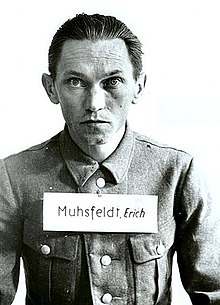Erich Muhsfeldt
Erich Mußfeldt | |
|---|---|
 Erich Mußfeldt at the Auschwitz Trial of 1947 in Kraków | |
| Born | February 18, 1913 |
| Died | January 24, 1948 (aged 34) |
| Nationality | German |
| Occupation | services in extermination camps as SS-Oberscharführer |
| Years active | 1940–1945 |
| Known for | heading the crematoria of the Majdanek and Auschwitz concentration camps |
Erich Mußfeldt, (18 February 1913 – 24 January 1948) was a German war criminal, an SS NCO who served in two extermination camps during World War II in occupied Poland: Auschwitz and Majdanek.[1] He was arrested and charged by the Allies originally in 1946,[2] then transferred to Poland where the full extent of his war crimes was revealed thanks to new evidence. He was retried by the Supreme National Tribunal at the Auschwitz Trial in Kraków, and found guilty of crimes against humanity. Muhsfeldt was sentenced to death by hanging in December 1947, and executed on 24 January 1948.[3]
Muhsfeldt was a baker in civilian life.[4] At the time of his service in the SS-Totenkopfverbände he was reportedly married with one son. The fate of his wife is unclear. According to Miklós Nyiszli,[5] his wife was killed in an air raid, and his son sent to the Russian front.[5]
World War II atrocities
Originally Muhsfeldt served with the German SS-Sonderkommando at Auschwitz I in 1940. He was transferred to the work/extermination camp at Majdanek on 15 November 1941. He was involved in the final mass shooting of the camp's remaining Jewish inmates known as the Operation Harvest Festival or "Erntefest". It was the largest single-day, single-camp massacre of the Holocaust,[6] totalling 43,000 in three nearby locations.[7] When the Majdanek camp was liquidated, he transferred back to Auschwitz, where he then served as supervising SS officer of the Jewish Sonderkommando in Crematorium II and III in Auschwitz II (Birkenau).
Upon his return to Auschwitz, Muhsfeldt had an unusual relationship with renowned Jewish-Hungarian pathologist Miklós Nyiszli, who was forced to carry out autopsies on behalf of Josef Mengele.[5] Nyiszli survived the war and later gave evidence about what happened at Auschwitz. Nyiszli described one incident when Muhsfeldt came to him for a routine check-up, after shooting 80 prisoners in the back of the head prior to their cremation. Nyiszli commented that Muhsfeldt's blood pressure was high, and inquired as to whether this could be related to the recent increase in "traffic", as the mass murder of newly arrived victims was euphemistically called. Muhsfeldt replied angrily that it made no difference to him, whether he shot one person or eighty. If his blood pressure was too high, it was because he drank too much he said.[5]
Nyiszli described an exceedingly rare occurrence, in which an inmate girl 15 or younger due to highly unusual circumstances, managed to survive the gas chamber and, with medical help from Nyiszli and others after she was discovered alive, was partially recovering. Nyiszli took up her case with Muhsfeldt asking that her life be spared. Muhsfeldt replied "There's no way of getting round it, the child will have to die." Nyiszli explains that "Half an hour later the young girl was led, or rather carried, into the furnace room hallway, and there [Muhsfeldt] sent another in his place to do the job. A bullet in the back of the neck..."[8]
After the war had ended, Muhsfeldt was arrested and charged by the War Crimes Group, European Command initially. He was retried in Kraków by the Supreme National Tribunal in 1947, where he was sentenced to death for his war crimes. He was executed by hanging on 24 January 1948.[3]
Muhsfeldt appears as a minor character in the 1983 James Michener novel Poland, and is portrayed by Harvey Keitel in the 2001 film The Grey Zone.
Notes
- ^ Elissa Mailänder Koslov (2014). "Vous lisez. Work, Violence and Cruelty. An Everyday Historical Perspective on Perpetrators in Nazi Concentration Camps". Interrogation of Erich Mußfeldt, 14.8.1947 in Krakow. Centre international de formation européenne. pp. 29–51. Retrieved 10 December 2014.
- ^ Deputy Judge Advocates Office (21 May 1947). United States vs. Friedrich Becker, et al (PDF file, direct download 9,71 MB). Dachau, Germany: War Crimes Group. European Command. pp. 1, 3. Retrieved 10 December 2014.
{{cite book}}:|work=ignored (help) - ^ a b AHF (2013). "Auschwitz Trial (November-December 1947)". The Holocaust. Jewish Virtual Library.org. Retrieved 2013-04-23.
- ^ "MUHSFELDT alias MUSSFELDT - Załoga SS KL Auschwitz - Pamięć.pl - portal edukacyjny IPN". pamiec.pl. Retrieved 19 April 2018.
- ^ a b c d Miklós Nyiszli (1 September 2007) [1946]. "An eyewitness from Auschwitz: book citations online". The Holocaust documents. Auschwitz: A Doctor's Eyewitness Account (a memoir). Arcade Publishing. Archived from the original on December 4, 2002. Retrieved 10 December 2014 – via Internet Archive.
Publication history and details at Goodreads.
{{cite web}}: External link in|quote= - ^ USHMM (May 11, 2012). "Soviet forces liberate Majdanek". Lublin/Majdanek: Chronology. United States Holocaust Memorial Museum, Washington, DC. Retrieved 2013-04-13.
- ^ Jennifer Rosenberg. "Aktion Erntefest". 20th Century History. About.com Education. Archived from the original on 2016-12-27. Retrieved 2013-04-16.
- ^ "An Eyewitness". auschwitz.dk. Retrieved 19 April 2018.
